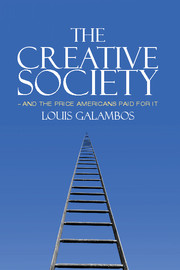Book contents
- Frontmatter
- Contents
- Preface
- 1 1931
- 2 Life, Death, and Learning in the Cities
- 3 Toward a New Economy, 1890 to 1930
- 4 State Crafting – American Style
- 5 Confronting the World
- 6 Winners and Losers, 1890 to 1930
- 7 New Deal Experiments
- 8 Fighting On God’s Side
- 9 The New Aristocracy, 1946 to 1969
- 10 The Suburban Conquest of the 1960s
- 11 Empire in the American Century
- 12 The Tattered Empire of the 1970s
- 13 The Cracked Core
- 14 The American Solution, 1981 to 2001
- 15 Conservatism: Rhetoric and Realities, 1981 to 2001
- 16 The Hegemony Trap
- 17 The American Dream, 1981 to 2001
- 18 The Creative Society in Danger
- Acknowledgments
- Index
- References
9 - The New Aristocracy, 1946 to 1969
Published online by Cambridge University Press: 05 June 2012
- Frontmatter
- Contents
- Preface
- 1 1931
- 2 Life, Death, and Learning in the Cities
- 3 Toward a New Economy, 1890 to 1930
- 4 State Crafting – American Style
- 5 Confronting the World
- 6 Winners and Losers, 1890 to 1930
- 7 New Deal Experiments
- 8 Fighting On God’s Side
- 9 The New Aristocracy, 1946 to 1969
- 10 The Suburban Conquest of the 1960s
- 11 Empire in the American Century
- 12 The Tattered Empire of the 1970s
- 13 The Cracked Core
- 14 The American Solution, 1981 to 2001
- 15 Conservatism: Rhetoric and Realities, 1981 to 2001
- 16 The Hegemony Trap
- 17 The American Dream, 1981 to 2001
- 18 The Creative Society in Danger
- Acknowledgments
- Index
- References
Summary
Victory in World War II and a prosperous economy gave the growing professional class a powerful position in American society. The images were compelling. The nation's scientists and engineers had helped win the greatest war in American history – a moral as well as a military victory. They had given the country more than just weapons to use overseas. At home, they were opening new frontiers in the medical sciences with remarkable innovations in the treatment of human and animal diseases. New drugs – the sulfa drugs and penicillin especially – had given doctors the ability to treat internal infections for the first time in the world's history. Physicists had made breakthroughs as well, expanding our understanding of the material world and, perhaps, the universe. Economists were no longer locked into a brand of classical and neoclassical analysis that left them and their governments with little room to maneuver when problems arose.
Good news like this vibrated through America society, out of the research universities, out of the big cities and into the countryside and the small towns. In our small town of Princeton, Indiana, the professions were revered. With the exception of Lou Galambos’ early self-promotion as a “mining engineer,” neither he nor my mother had been able to buck the odds and acquire a coveted place in the professions. But they knew how important the professions were and so did many people in Princeton. This knowledge was so deeply planted in the small-town culture that it seldom had to be discussed. I can't remember it ever being a subject talked about at home or in the schools. But our teachers all considered themselves to be professionals, as did the school administrators. They all pointed us toward a college or university as the next big step toward a professional career. There was a steady stream of “suggestions” about schoolwork and about what it took to make that next step, about the difference, say, between a “B” and an “A” in one of your courses. It started early and it never let up.
- Type
- Chapter
- Information
- The Creative Society – and the Price Americans Paid for It , pp. 132 - 150Publisher: Cambridge University PressPrint publication year: 2011



